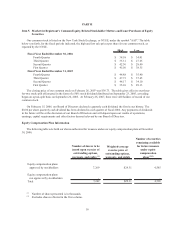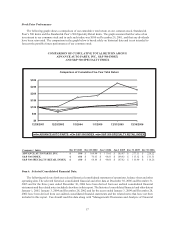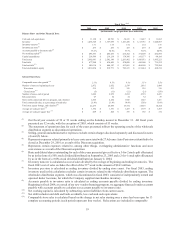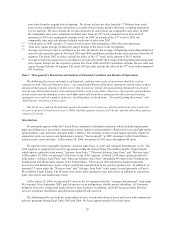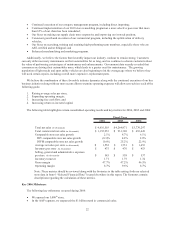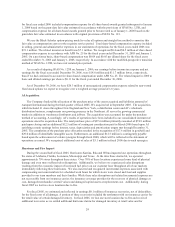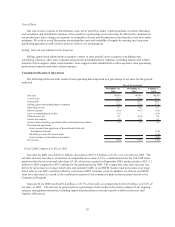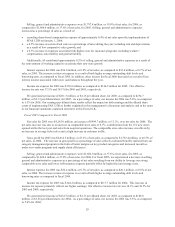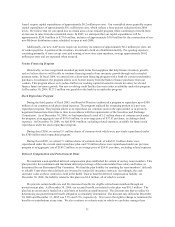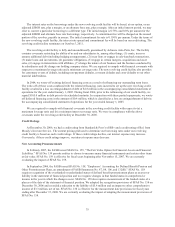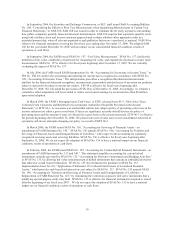Advance Auto Parts 2006 Annual Report Download - page 49
Download and view the complete annual report
Please find page 49 of the 2006 Advance Auto Parts annual report below. You can navigate through the pages in the report by either clicking on the pages listed below, or by using the keyword search tool below to find specific information within the annual report.Warranty Reserves
Our vendors are primarily responsible for warranty claims. We are responsible for merchandise sold under
warranty which is not covered by vendor warranties (primarily batteries). We record a reserve for future warranty
claims as an increase in our cost of sales based on current sales of the warranted products and historical claim
experience. If claims experience differs from historical levels, revisions in our estimates may be required, which
could have an impact on our consolidated statement of operations. A 10% change in the warranty reserves at
December 30, 2006 would have affected net income by approximately $0.8 million for the fiscal year ended
December 30, 2006.
Self-Insured Reserves
We are self-insured for general and automobile liability, workers' compensation and the health care claims of
our team members, although we maintain stop-loss coverage with third-party insurers to limit our total liability
exposure. A reserve for liabilities associated with these losses is established for claims filed and claims incurred but
not yet reported using actuarial methods followed in the insurance industry and our historical claims experience.
While we do not expect the amounts ultimately paid to differ significantly from our estimates, our self-insurance
reserves and corresponding selling, general and administrative expenses could be affected if future claim experience
differs significantly from historical trends and actuarial assumptions. A 10% change in our self-insurance liabilities
at December 30, 2006 would have affected net income by approximately $4.4 million for the fiscal year ended
December 30, 2006.
Leases and Leasehold Improvements
We lease certain store locations, distribution centers, office space, equipment and vehicles. We account for our
leases under the provisions of SFAS No. 13, “Accounting for Leases,” and subsequent amendments which require
that leases be evaluated and classified as operating leases or capital leases for financial reporting purposes. Certain
leases contain rent escalation clauses, which are recorded on a straight-line basis over the initial term of the lease
with the difference between the rent paid and the straight-line rent recorded as a deferred rent liability. Lease
incentive payments received from landlords are recorded as deferred rent liabilities and are amortized on a straight-
line basis over the lease term as a reduction in rent. In addition, leasehold improvements associated with these
operating leases are amortized over the shorter of their economic lives or the respective lease terms. The term of
each lease is generally the initial term of the lease unless external economic factors were to exist such that renewals
potentially provided for in the lease are reasonably assured to be exercised. In those instances the renewal period
would be included in the lease term for purposes of establishing an amortization period and determining if such
lease qualified as a capital or operating lease.
Impairment of Long-Lived Assets
We primarily invest in property and equipment in connection with the opening and remodeling of stores and in
computer software and hardware. We periodically review our store locations and estimate the recoverability of our
assets, recording an impairment charge, if necessary, when we decide to close the store or otherwise determine that
future undiscounted cash flows associated with those assets will not be sufficient to recover the carrying value. This
determination is based on a number of factors, including the store’s historical operating results and cash flows,
estimated future sales growth, real estate development in the area and perceived local market conditions that can be
difficult to predict and may be subject to change. In addition, we regularly evaluate our computer-related and other
long-lived assets and may accelerate depreciation over the revised useful life if the asset is expected to be replaced
or has limited future value. When assets are retired or otherwise disposed of, the cost and related accumulated
depreciation or amortization are removed from the accounts, and any resulting gain or loss is reflected in income for
that period. Our impairment loss calculations require management to apply judgment in estimating future cash
flows and asset fair values, including forecasting useful lives of the assets and selecting the discount rate that reflects
the risk inherent in future cash flows. If actual results are not consistent with our assumptions and judgments used
in estimating future cash flows and asset fair values, we may be exposed to additional impairment losses that could
be material to our results of operations.
26


